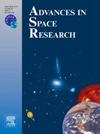A new methodology for determining the long-term behavior of earth surface deformations from InSAR results
IF 2.8
3区 地球科学
Q2 ASTRONOMY & ASTROPHYSICS
引用次数: 0
Abstract
The InSAR method is an effective method of presenting the temporal change and behavior characteristics of surface deformations to users and monitoring deformations. In general, it is possible to determine the spatial distribution and magnitude of surface deformations using InSAR analysis results. However, more detailed analyses should be performed to reveal and interpret the long-term behavior of deformations from these results. It is especially important to classify deformation velocities and present the temporal change and behavior characteristics of deformations by analyzing the densities of these classes and their periodic changes. This study developed a new methodology and software to present the temporal change and behavior characteristics of deformations to users. With the new methodology and software developed, values such as time-dependent increasing/decreasing trend of deformations, continuity, velocity value and class, and areal ratio/density can be determined and long-term behavior characteristics of deformations can be revealed. It is possible to make more reliable predictions of future behavior by considering the current increasing or decreasing trend of deformation behavior. The methodology and software developed were used to monitor surface deformations at the dump site of Kangal/Kalburçayırı open-pit coal mine, and the results were discussed. Owing to the method developed, deformation behavior was determined, and the prospective support heel precaution was taken. The new situation and deformation behavior that occurred as a result of this precaution were examined with the same methodology and software, and the success of the support heel was discussed.
求助全文
约1分钟内获得全文
求助全文
来源期刊

Advances in Space Research
地学天文-地球科学综合
CiteScore
5.20
自引率
11.50%
发文量
800
审稿时长
5.8 months
期刊介绍:
The COSPAR publication Advances in Space Research (ASR) is an open journal covering all areas of space research including: space studies of the Earth''s surface, meteorology, climate, the Earth-Moon system, planets and small bodies of the solar system, upper atmospheres, ionospheres and magnetospheres of the Earth and planets including reference atmospheres, space plasmas in the solar system, astrophysics from space, materials sciences in space, fundamental physics in space, space debris, space weather, Earth observations of space phenomena, etc.
NB: Please note that manuscripts related to life sciences as related to space are no more accepted for submission to Advances in Space Research. Such manuscripts should now be submitted to the new COSPAR Journal Life Sciences in Space Research (LSSR).
All submissions are reviewed by two scientists in the field. COSPAR is an interdisciplinary scientific organization concerned with the progress of space research on an international scale. Operating under the rules of ICSU, COSPAR ignores political considerations and considers all questions solely from the scientific viewpoint.
 求助内容:
求助内容: 应助结果提醒方式:
应助结果提醒方式:


